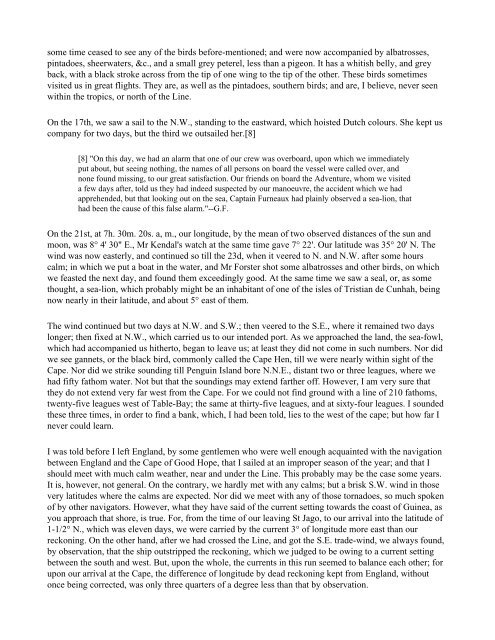A General History & Collection of Voyages and Travels ... - Nauticus
A General History & Collection of Voyages and Travels ... - Nauticus
A General History & Collection of Voyages and Travels ... - Nauticus
Create successful ePaper yourself
Turn your PDF publications into a flip-book with our unique Google optimized e-Paper software.
some time ceased to see any <strong>of</strong> the birds before-mentioned; <strong>and</strong> were now accompanied by albatrosses,pintadoes, sheerwaters, &c., <strong>and</strong> a small grey peterel, less than a pigeon. It has a whitish belly, <strong>and</strong> greyback, with a black stroke across from the tip <strong>of</strong> one wing to the tip <strong>of</strong> the other. These birds sometimesvisited us in great flights. They are, as well as the pintadoes, southern birds; <strong>and</strong> are, I believe, never seenwithin the tropics, or north <strong>of</strong> the Line.On the 17th, we saw a sail to the N.W., st<strong>and</strong>ing to the eastward, which hoisted Dutch colours. She kept uscompany for two days, but the third we outsailed her.[8][8] "On this day, we had an alarm that one <strong>of</strong> our crew was overboard, upon which we immediatelyput about, but seeing nothing, the names <strong>of</strong> all persons on board the vessel were called over, <strong>and</strong>none found missing, to our great satisfaction. Our friends on board the Adventure, whom we visiteda few days after, told us they had indeed suspected by our manoeuvre, the accident which we hadapprehended, but that looking out on the sea, Captain Furneaux had plainly observed a sea-lion, thathad been the cause <strong>of</strong> this false alarm."--G.F.On the 21st, at 7h. 30m. 20s. a, m., our longitude, by the mean <strong>of</strong> two observed distances <strong>of</strong> the sun <strong>and</strong>moon, was 8° 4' 30" E., Mr Kendal's watch at the same time gave 7° 22'. Our latitude was 35° 20' N. Thewind was now easterly, <strong>and</strong> continued so till the 23d, when it veered to N. <strong>and</strong> N.W. after some hourscalm; in which we put a boat in the water, <strong>and</strong> Mr Forster shot some albatrosses <strong>and</strong> other birds, on whichwe feasted the next day, <strong>and</strong> found them exceedingly good. At the same time we saw a seal, or, as somethought, a sea-lion, which probably might be an inhabitant <strong>of</strong> one <strong>of</strong> the isles <strong>of</strong> Tristian de Cunhah, beingnow nearly in their latitude, <strong>and</strong> about 5° east <strong>of</strong> them.The wind continued but two days at N.W. <strong>and</strong> S.W.; then veered to the S.E., where it remained two dayslonger; then fixed at N.W., which carried us to our intended port. As we approached the l<strong>and</strong>, the sea-fowl,which had accompanied us hitherto, began to leave us; at least they did not come in such numbers. Nor didwe see gannets, or the black bird, commonly called the Cape Hen, till we were nearly within sight <strong>of</strong> theCape. Nor did we strike sounding till Penguin Isl<strong>and</strong> bore N.N.E., distant two or three leagues, where wehad fifty fathom water. Not but that the soundings may extend farther <strong>of</strong>f. However, I am very sure thatthey do not extend very far west from the Cape. For we could not find ground with a line <strong>of</strong> 210 fathoms,twenty-five leagues west <strong>of</strong> Table-Bay; the same at thirty-five leagues, <strong>and</strong> at sixty-four leagues. I soundedthese three times, in order to find a bank, which, I had been told, lies to the west <strong>of</strong> the cape; but how far Inever could learn.I was told before I left Engl<strong>and</strong>, by some gentlemen who were well enough acquainted with the navigationbetween Engl<strong>and</strong> <strong>and</strong> the Cape <strong>of</strong> Good Hope, that I sailed at an improper season <strong>of</strong> the year; <strong>and</strong> that Ishould meet with much calm weather, near <strong>and</strong> under the Line. This probably may be the case some years.It is, however, not general. On the contrary, we hardly met with any calms; but a brisk S.W. wind in thosevery latitudes where the calms are expected. Nor did we meet with any <strong>of</strong> those tornadoes, so much spoken<strong>of</strong> by other navigators. However, what they have said <strong>of</strong> the current setting towards the coast <strong>of</strong> Guinea, asyou approach that shore, is true. For, from the time <strong>of</strong> our leaving St Jago, to our arrival into the latitude <strong>of</strong>1-1/2° N., which was eleven days, we were carried by the current 3° <strong>of</strong> longitude more east than ourreckoning. On the other h<strong>and</strong>, after we had crossed the Line, <strong>and</strong> got the S.E. trade-wind, we always found,by observation, that the ship outstripped the reckoning, which we judged to be owing to a current settingbetween the south <strong>and</strong> west. But, upon the whole, the currents in this run seemed to balance each other; forupon our arrival at the Cape, the difference <strong>of</strong> longitude by dead reckoning kept from Engl<strong>and</strong>, withoutonce being corrected, was only three quarters <strong>of</strong> a degree less than that by observation.


